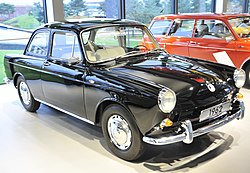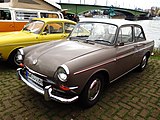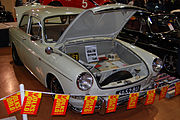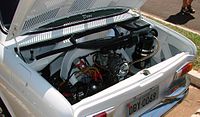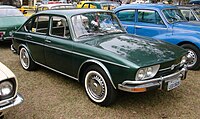VW type 3
| Volkswagen type 3 | |
|---|---|
| Production period: | 1961-1973 |
| Class : | Middle class |
| Body versions : | Limousine , station wagon |
| Successor: | VW Passat B1 |
The Type 3 is a passenger car model from Volkswagen that was available as a sedan with a notchback and hatchback (TL, standing for touring sedan) and as a station wagon ( Variant ). It was also the first mid-range model from VW, whereby, like the Beetle , it is a class lower in terms of dimensions and new price, but is counted as a mid-range because of its comparatively large displacement.
The car was presented as the VW 1500 at the 40th IAA in Frankfurt and was delivered to the VW trade organization from September 7, 1961. Almost 2.6 million cars were produced by July 1973.
The numbering was done chronologically:
Type 1 is the VW Beetle (from 1938), Type 2 is the abbreviation for the VW Transporter (from 1950), Type 3 is the mid-range model described here (from 1961) and Type 4 is the even larger VW 411 (from 1968) .
Model history
General
For the Type 3, VW did not break with the pre-war concept of the VW Beetle. The wheelbase and the central tubular frame instead of a self-supporting body were retained , as was the principle of the fan-cooled rear engine . The main differences to the Beetle were, on the one hand, the transition to a pontoon body , which allowed a little more space than the Beetle. All versions had a front trunk that was larger and designed in a more usable shape and an externally accessible trunk at the rear above the engine.
The front axle was new: the axle support was spot-welded from deep-drawn sheet metal shells and the torsion bar springs were no longer made from leaf springs, but rather as round bars. A long spring bar acted on the lower crank arm of a front wheel and was clamped on the opposite side on the axle beam. In addition, they were set at a slight angle and crossed in the middle of the car. The axle mounts on the frame were further apart than on the Beetle and the axle support was mounted in rubber. Another difference was in the engine. The drive, known as a flat engine , had more displacement than that of the Beetle and a modified air cooling : The radial fan was flanged to the rear end of the crankshaft and no longer “stood” on the engine. The oil cooler was now installed horizontally and no longer hindered the cooling of the third cylinder (left front), which tended to overheat in engines with an upright blower box and could cause serious engine damage ( piston seizure ). The flat engine was a little longer, but at 40 cm high, it was significantly lower, making it possible for the Variant station wagon as well as the rear trunk of the sedan and the TL, which was accessible from the outside. For maintenance purposes, the engine was accessible through a flap in the trunk floor. Another progressive aspect was later found in the VW Type 3: from the end of 1967 the VW 1600 E was the first German series car to be offered with electronic manifold injection (Bosch D-Jetronic ).
As a sedan, the Type 3 cost 6400 DM when it appeared, almost 1100 DM more than the Beetle. The press doubted whether VW would succeed in establishing the car in the mid-range segment, as it had a smaller body and less space compared to models from competitors such as the Ford Taunus 17 M or the Opel Rekord A. But it was ultimately a success on the market. In particular the Variant , the first VW station wagon with this name, was very popular with a share of 43% of type 3 registrations (1970).
VW 1500/1600 (1961-1969)
| VW 1500/1600 | |
|---|---|
|
VW 1500 notchback (1962) |
|
| Production period: | 1961-1969 |
| Body versions : | Limousine , station wagon |
| Engines: |
Petrol engines : 1.5–1.6 liters (33–39.7 kW) |
| Length: | 4225 mm |
| Width: | 1605-1640 mm |
| Height: | 1465-1475 mm |
| Wheelbase : | 2400 mm |
| Empty weight : | 880-975 kg |
- 09.1961 - The VW 1500 appears as a notchback and variant ( station wagon ).
- 08.1963 - VW 1500 S with two- carburetor engine and 54 hp, changes to indicators and rear lights, "S" models with chrome trim, VW 1500 renamed 1500 N , "N" models without chrome trim and with simpler equipment.
- 08.1965 - VW 1600 TL ( T ouren- L imousine, popularly known sometimes as " T raurige L dissolution" or " T raurige L inie" mocked) with hatchback , a larger engine, footwell heating and a luggage compartment of 260 liters for 6690 DM factory, still renamed with 54 HP, 1500 N to 1500 A , with flat-flow single carburetor and 45 HP, notchback sedan initially only available as a standard model. Introduction of disc brakes on the front axle, associated with new wheels with a smaller bolt circle and four instead of five wheel bolts.
- 1966 - Electrical system in 12-volt version, notchback sedan with better equipment also available as VW 1600 L , as the 1600 TL with hatchback body did not meet with unanimous approval. All models were now designated as VW 1600; the VW 1600 A with 45 HP still has a 1.5 liter engine.
- 1967 - automatic model with modern semi-trailing arm rear axle. The 54 hp engine was also optionally available with the Bosch D-Jetronic intake manifold injection . From August 1967 (model year 1968) the filler neck of the fuel tank can be reached via an external flap, just like the Beetle (Type 1), and not only after opening the front hood.
VW 1600 (1969–1973)
| VW 1600 | |
|---|---|
|
VW 1600 TL (hatchback) (1969–1973) |
|
| Production period: | 1969-1973 |
| Body versions : | Limousine , station wagon |
| Engines: |
Petrol engines : 1.5–1.6 liters (33–39.7 kW) |
| Length: | 4340-4368 mm |
| Width: | 1605-1640 mm |
| Height: | 1470 mm |
| Wheelbase : | 2400 mm |
| Empty weight : | 1010-1035 kg |
- 08.1969 - revision of the body ("long schnauzer"), wide bumpers, large front indicators and rear lights, different position of the license plate on the TL. All models got the semi-trailing arm axle instead of the swing axle.
- 07.1973 - Production of the 1600 series is discontinued.
Final assembly at the Volkswagen plant in Wolfsburg , January 1973
VW 1600 Variant as a command vehicle for the fire brigade
2,583,015 piece of type 3 were constructed, almost half (1202483) as Variant .
Type 3 from the beginning of 1962, a two-seater was Karmann Ghia - Coupe delivery on VW Type 34 . Convertible versions, derived from the sedan and the Karmann Ghia, were built for testing, but not approved for series production. The same thing happened with a four-door development that did not go into series production.
Technical data VW 1500/1600
| 1500, 1500 N | 1500 p | 1500 A, 1600 A | 1600, 1600 L, 1600 TL | 1600 LE, 1600 TLE | |
|---|---|---|---|---|---|
| engine | flat four-cylinder four-stroke boxer rear engine; air cooled; central camshaft ; overhead valves operated by push rods and rocker arms; Oil bath air filter ; firing order 1-4-3-2 | ||||
| Displacement | 1493 cm 3 | 1584 cm 3 | |||
| Bore × stroke | 83 × 69 mm | 85.5 × 69 mm | |||
| Power at 1 / min | 45 hp (33 kW) at 3800 | 54 hp (40 kW) at 4200 | 45 hp (33 kW) at 3700 | 54 hp (40 kW) at 4000 | |
| Carburetor / manifold injection | a flat stream | two downdraft Solex 32 PDSIT |
a flat stream | two downdraft | Bosch D-Jetronic |
| Torque at 1 / min | 106 Nm at 2000 | 106 Nm at 2400 | 106 Nm at 2400 | 110 Nm at 2200 | |
| transmission | Four-speed, fully synchronized | Four-speed, fully synchronized, from 1967 also three-speed fully automatic | |||
| Electrics | 6 volt alternator 200 watt , battery 77 Ah |
12 volts from 8/1966 | |||
| body | All-metal structure screwed to the platform frame with a central support | ||||
| Front axle | Independent suspension on longitudinal crank arm, anti- roll bar, transverse torsion bar suspension , hydraulic telescopic shock absorbers | ||||
| Brakes in front | drum brake | Disc brake | |||
| Rear axle | Pendulum axle with trailing arms, transverse torsion spring bars and hydraulic telescopic shock absorbers, from 9/1967 automatic models with trailing arms, from 8/1968 trailing arms in series | ||||
| Rear brakes | drum brake | ||||
| Tires | 6.00 × 15 (from 1967 on request 165 SR 15) on 4.5 J x15 | ||||
| wheelbase | 2400 mm | ||||
| Length × width × height | 4225 × 1605 × 1475 mm (Variant height = 1465 mm) from 1969 4340 × 1605 × 1470 mm |
||||
| Top speed | 125 km / h | 135 km / h | 125 km / h | 135 km / h | 135 km / h |
| construction time | 1961-1965 | 1963-1965 | 1965-1973 | 1965-1973 | 1968-1973 |
VW 1600 in Brazil
The VW 1600 built in Brazil from 1968 to 1980 differs technically from the European model. The chassis was taken over from the VW Karmann-Ghia with the wider base plates. It had the Beetle chassis with a pendulum axle at the rear but disc brakes at the front and, like the Beetle, it had a tall engine with a V-belt driven fan. The Brazilian VW 1600 was also available with four doors.
Timetable
- 1968 - Presentation of the Brazilian VW 1600 as a four-door notchback sedan, still with the high-rise cooling system of the Beetle. Quite clumsy design.
- 1969 - The range is expanded to include a station wagon with only two side doors and continuous rear side windows. For the first time with the flat engine of the German type 3. Name as in Germany VW 1600 Variant .
- 1970 - The range is expanded to include a two-door hatchback sedan. Name as in Germany VW 1600 TL . For all models, double headlights instead of the rectangular headlights previously used.
- 1971 - The production of the notchback sedan is discontinued. The TL and Variant received a new front design that was designed in Brazil and was subsequently also used for the SP 2 sports car , the smaller Brasilia and in Germany for the revised 412 . The hatchback is now also available with four doors.
- 1974 - Just one year after its introduction in Germany , the VW Passat is also produced in Brazil. This means that a far more modern car is available in the middle class. The VW 1600 continued to be built, but demand fell sharply in the period that followed.
- 1976 - The production of the hatchback is stopped. Only the 1600 Variant remains on offer; the first generation Passat Variant is not offered in Brazil.
- 1977 - Instead, the VW 1600 Variant is thoroughly revised. Completely new, much more modern body, which at first glance can be confused with the Brasilia; but the Brasilia is smaller. Name VW Variant II . Technically, it differs mainly from its predecessor in the strut front axle, which enables the front trunk to be designed more cheaply.
- 1980 - Production of the Variant II is discontinued.
- 1982 - Production of the Brasília is also discontinued. With the Gol, Voyage, Parati , Passat and (from 1984) Santana , VW is now also relying on front-engine and front-wheel drive in Brazil.
Production numbers
- Notchback sedan (1968–1971) 24,475
- TL hatchback sedan (1970–1976) 109,515
- Variant (1969-1977) 256,760
- Variant II (1977-1980) 41,002
- Total: 431,752
Technical specifications
| VW 1600: | Sedan / Variant | TL | Variant II |
|---|---|---|---|
| Engine: | 4-cylinder boxer engine (four-stroke) | ||
| Displacement: | 1584 cc | ||
| Bore × stroke: | 85.5 × 69 mm | ||
| Performance at 1 / min: | 37 kW (50 DIN PS) at 4600 |
40 kW (54 DIN PS) at 4600 |
41 kW (56 DIN PS) at 4200 |
| Max. Torque at 1 / min: | 112 Nm at 2200 | 112 Nm at 2600 | 108 Nm at 3000 |
| Compression: | 7.2: 1 | ||
| Mixture preparation: | 1 downdraft carburetor Solex H30IC | 1 downdraft carburetor Solex 32 PDSIT | |
| Valve train: | Central camshaft, drive via gear wheels, light alloy cylinder heads and engine block | ||
| Cooling: | Air cooling (fan) | ||
| Transmission: | 4-speed gearbox, rear-wheel drive center shift |
||
| Front suspension: | Double crank arm axle, transverse torsion bars | Suspension strut axle, triangular wishbone, stabilizer | |
| Rear suspension: | Pendulum axle, trailing arm, balancing spring, transverse torsion bars | ||
| Brakes: | Disc brakes at the front (diameter 27.8 cm), drum brakes at the rear | ||
| Steering: | Worm steering | Rack and pinion steering | |
| Body: | Sheet steel on a central tubular frame | ||
| Track width front / rear: | 1315/1360 mm | 1365/1400 mm | |
| Wheelbase: | 2400 mm | 2495 mm | |
| Dimensions: | 4250 × 1580 × 1430 mm | 4325 × 1630 × 1430 mm | |
| Empty weight: | Lim .: 862 kg Variant: 1025 kg |
920 kg | 970 kg |
| Top speed: | 135 km / h | 140 km / h | 138 km / h |
| 0-100 km / h: | not specified | 20.5 s | |
| Consumption (liters / 100 kilometers, DIN): | 9.0 N | ||
Source: Automobil Revue , catalog numbers 1973, 1979
Individual evidence
- ↑ September 7, 1961 - 56 years ago today. wolfsburger-nachrichten.de from September 6, 2017, accessed on September 12, 2017.
- ↑ http://www.lov2xlr8.no/brochures/1960/64vwv/64vwv.html prospectus, 1964
- ^ Test VW 1500 In: AMS 21/1961, pp. 24-31
- ↑ a b c d e f g h i j k l Werner Oswald: German cars 1945–1990 . Volume 3. Motorbuch Verlag, Stuttgart 2001. ISBN 3-613-02116-1 . Pp. 52-61
literature
- Hans G. Mayer-Stein: The big VW: Nordhoffs legacy: VW 1500/1600, 411/412 . Verlag Karl Goerner, Karlsruhe 1994, ISBN 3-9803665-0-2
- OLDTIMER MARKT issue 12 December 1988, title: VW 1500/1600 Type 3
- Colin Burnham: The fascination of Volkswagen. VW rarities under the Californian sun. SERAG AG 1988, ISBN 3-908007-41-0
